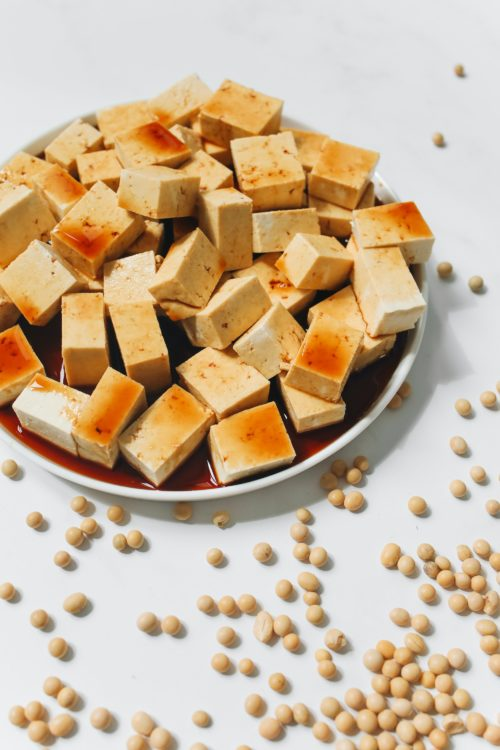Soy Sauce vs Liquid Aminos: the Ultimate Umami Sauce Face-off
- No Comments

In the battle of liquid aminos vs. soy sauce, liquid aminos seem to come out on top.
If you’re like me, you love the sweet, savory, salty pop of a good soy sauce with your sushi. What if I told you that you could find that same flavor in an organic, gluten-free, preservative-free, keto-friendly package? That’s right; I’m talking about liquid aminos!
More importantly, liquid aminos contain all essential amino acids, the building blocks of protein that we need to get through our diet. If soy or salt is your concern, we’ll also cover coconut liquid aminos. Coconut aminos are soy-free and offer half the salt of liquid aminos and soy sauce.
- Liquid aminos vs soy sauce: what is the difference?
- How are liquid aminos made?
- How is soy sauce made?
- Liquid aminos vs soy sauce: nutrition facts
- Bottom line: are liquid aminos better than soy sauce for your health?
Whether you are a longtime fan of the famous Bragg’s Liquid Aminos or are searching for a switch from soy, read on to get some facts, figures and find out which umami sauce is the boss!
Liquid aminos vs soy sauce: what is the difference?
Liquid aminos and soy sauce can be used interchangeably, but there are a few key differences between how the products are made and the nutrition they provide.
The critical difference is that liquid aminos provide nutritionally value amino acids, while soy sauce does not.

Liquid aminos are…
Liquid aminos are mixtures of amino acids and water. Liquid aminos are made from soybeans or coconut blossom sap. They contain non-essential amino acids, which our bodies can make, and essential amino acids, which we have to get through our diet. Amino acids are the primary building blocks of proteins and are necessary for many biological functions.
Liquid amino preparations are an easy substitute for soy sauce, with a more mild umami flavor and a hint of sweetness. They are made from non-GMO soybeans and are kosher, gluten-free, and keto-friendly.
Soy sauce is…
Soy sauce is a dark, salty sauce of Chinese or Japanese origin. Like Braggs Liquid Aminos, the main ingredient of soy sauce is soybeans. Unlike Braggs, however, soy sauce involves cooking soybeans with wheat and fermenting in a salty brine. The use of wheat in the preparation means that soy sauce is neither gluten-free nor keto-friendly.
How are liquid aminos made?
Soy-based liquid aminos are made by applying an acid solution to soybeans to break them into amino acids. This solution is then treated to lower the acidity and combined with water. In the case of Bragg’s liquid aminos, the final product contains just two ingredients, amino acids, and water.
A newer product gaining popularity is coconut aminos. Coconut aminos are produced by applying an acidic solution to coconut palm blossoms or fermenting them. Coconut aminos usually require additional ingredients, like sea salt or vinegar, to achieve the final flavor.

How is soy sauce made?
Traditionally, soy sauce is made by soaking and steaming soybeans. Then, roasted wheat flour and fungal spores are combined with the cooked soybean mixture. After these ingredients, brine is added, and the mix is left to ferment. Finally, the entire solution is filtered, heated to kill any fungus or bacteria, and packaged.
There are several variations of soy sauce primarily distinguished by brewing technique and soy to wheat ratio. Tamari sauce, which is most similar to liquid aminos, contains the least wheat and is very dark. White soy sauces use the most wheat. Less traditional, mass-produced soy sauce may use an acid solution to process the soybeans instead of the conventional cooking and soaking.
Liquid Aminos: Ingredients
- Vegetable protein (from organic soybeans)
- Water
Coconut Aminos: ingredients
- Organic coconut blossom nectar
- Water
- Organic apple cider vinegar
- Sea salt
Soy Sauce: ingredients
- Water
- Soybeans
- Wheat
- Salt
- Sodium Benzoate
Bottom line: are liquid aminos better than soy sauce for your health?
Yes, liquid aminos can provide significant health benefits over soy sauce.
The first significant benefit is what you are putting in your body. In our Betr blog post, Tired of Feeling Tired, we discuss the importance of consuming proteins to provide essential amino acids. Amino acids are necessary for muscle repair and energy metabolism, and liquid aminos provide these amino acids with minimal additional baggage.
Liquid aminos also provide health benefits in the sense of what you are not putting into your body. Betr Health believes in fueling your body with healthy, nutritious foods by avoiding unnecessary chemicals, potentially harmful GMO products, and common allergens and triggers. As discussed in Listening to Your Gut, these toxins and triggers can build up in our body and cause inflammation, skin issues, and a host of other symptoms.
Because liquid aminos are organic, non-GMO, and grain-free, they don’t contain the potential triggers of standard soy sauce. Another strike against soy sauce is preservatives, namely sodium benzoate, possibly contributing to inflammation and other health issues.
Are you allergic to soy or concerned about salt intake? Coconut aminos are an alternative that can provide all of the nutritional advantages of soy-based liquid aminos. Coconut aminos are not made from soybeans and contain half the salt of liquid aminos and soy sauce.
To wrap up this discussion, let’s review what we’ve learned about liquid aminos vs soy sauce:
- As opposed to most soy sauce, liquid aminos are made from organic, non-GMO soybeans
- Liquid aminos are gluten-free, whereas soy sauce is made with wheat
- Liquid aminos provide essential amino acids, which we need to get from our diet
- Coconut aminos do not contain soybeans and are lower in salt than soy sauce and soy-based liquid aminos.




